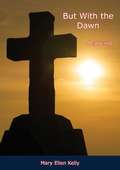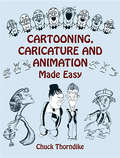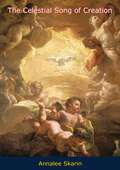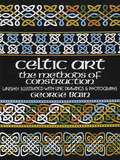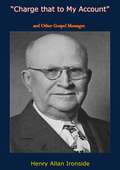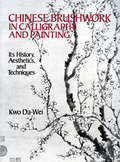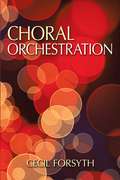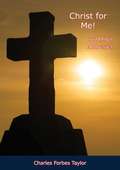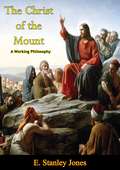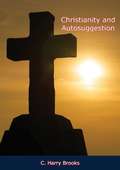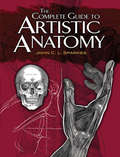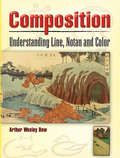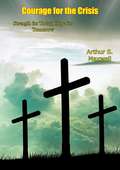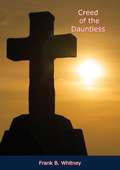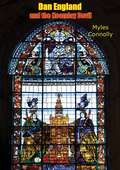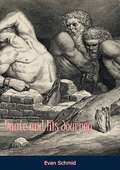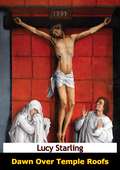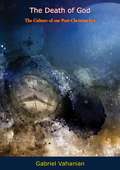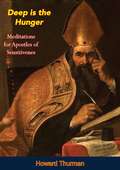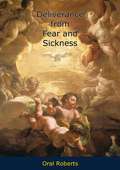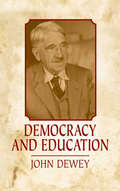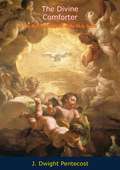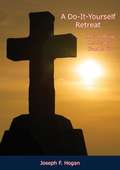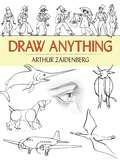- Table View
- List View
But With the Dawn, Rejoicing
by Mary KellyThis is the autobiography of a woman named Mary Ellen Kelly. In her teens she had begun to develop rheumatoid arthritis. By the age of 20 she was almost totally immobile. On a train she couldn’t use the sleeper car, but had to travel in the baggage car, strapped to a board. She had the use of only two fingers on one hand; it once took her over two hours to write a note just twenty-five words long. She had plenty of reason to feel sorry for herself, and indeed she did. In due time, however, she met Fr. Joseph Higgins, a Missionary of Our Lady of La Salette. One day he “read her the riot act,” so to speak, and shocked her into the realization that, especially as a woman of faith, her handicap gave her no excuse to do nothing. She began writing a monthly newsletter called “Seconds Sanctified,” specifically for shut-ins like herself. She had always been a devout Catholic, and now had discovered her place in the Church, encouraging others never to lose faith.Mary Ellen Kelly wrote BUT WITH THE DAWN REJOICING in 1959.
Cartooning, Caricature and Animation Made Easy
by Chuck ThorndikeWritten by an experienced teacher of cartooning, this volume combines The Secrets of Cartooning, the author's first and more elementary book, and The Art of Cartooning, his follow-up, in which he answered questions raised by readers of his earlier book. Each volume in this double edition is complete in itself as a series of lessons. The first part focuses on such basics as drawing the head, hands, and clothing; creating expressions; conveying motion; and obtaining shading effects. The second section presents a series of lessons in anatomy, followed by advice about drawing caricatures and detailed instructions for creating images for animated features and political cartoons.
The Celestial Song of Creation
by Annalee Skarin“Here is a record of glory, revealing the method of achieving the heights, the way to unfold understanding of the Almighty Truths of God.“If you would awaken your soul to the divine symphony of the Universe, follow the way of ‘overcoming,’ the Way Christ trod. The record of His Path, the eternal, inner truths of power and fulfillment are now open, the sacred, inner knowledge that has lain dormant and in the depths of your being.“Ludwig Van Beethoven, who had become deaf, humbly acknowledged that his Symphony No. 9 came to him directly from God, and that he merely transcribed it.“What is man’s soul? It is his true being, where God has placed a seed of Himself, and this seed contains the perfect answers to one’s outside problems and inner questioning. It is the source of all inspiration and contains the power of all achievement and happiness. The soul is the innermost being of man himself.“To contact the soul, one learns ‘to be still!’ This divine search fulfills man’s conquest of himself as he begins to live God’s laws. As one learns ‘to love God with all his heart, all his soul, all his mind, and all his strength,’ he begins to find the joy and the meaning of existence. The search is one that no man can make for another. It is a quest which each individual must undertake for himself. It is each individual’s own responsibility.”—Annalee Skarin
Celtic Art: The Methods of Construction
by George BainThe construction principles of Celtic art were re-discovered in the middle of the 20th century by George Bain. Until his writing, the intricate knots, interlacings, and spirals used in illuminating The Book of Kells and in decorating craftwork and jewelry seemed almost impossible, "the work of angels." In this pioneering work, George Bain shows how simple principles, no more difficult than those used in needlecraft, were used to create some of the finest artistic works ever seen. He also explains how you can use these principles in re-creating artifacts and in creating your own Celtic designs for art and craft work or even for recreational use.Step-by-step procedures carefully introduce the simple rules and methods of Celtic knot work and the well-known designs from the great manuscripts and stone work. Later chapters build up to complex knot work, spiral work, and key pattern designs, with special coverage of alphabets and the stylized use of animals, humans, and plants. Altogether over 225 different patterns are presented for your use, with hundreds of modification suggestions, 110 historical and modern artifacts showing designs in use, a great number of letters including six complete alphabets and 25 decorative initials, and a number of animal and human figures used in the original Celtic works.Artists, students, craftspeople, even children can work with these patterns and instructions for creating dynamic designs for use in leather work, in embroidery and other needle work, in metalwork, jewelry making, card design, borders, panels, illuminations, and in countless other ways. Mathematicians will find a great deal of pleasure in the geometric principles on which the patterns are based. Art historians and others interested in studying Celtic art will find a great number of outstanding art works and the best presentation in English for understanding Celtic design.
“Charge that to My Account” and Other Gospel Messages
by Henry IronsideBecause GOD has been pleased to set His seal of approval upon these simple gospel messages by using them in the awakening and salvation of sinners, they can be found here, in book form, in the earnest hope that many who read them may find joy and peace in believing!First published in 1931, Pastor H. A. Ironside’s “Charge that to My Account” and Other Gospel Messages contains 12 interesting studies, beginning with his best known gospel presentation based on Paul’s letter to Philemon, and includes “Will a Loving God Permit Anyone to Be Eternally Lost?” and “Inside the Veil, Outside the Camp.”
Chinese Brushwork in Calligraphy and Painting: Its History, Aesthetics, and Techniques (Dover Fine Art, History Of Art Series)
by Kwo Da-Wei"A volume of great value to the admirer of Chinese art that also contains much practical advice for the student." ― Library Journal When this book was first published, there were few if any important studies dealing with Chinese brushwork and its crucial role in Chinese art. The present volume, by a noted scholar, calligrapher, and artist, was the first significant treatment of the topic and remains among the foremost works devoted to the history, aesthetics, and techniques of the brush ― the single most important tool in Chinese fine art. The author begins by tracing the historical development of techniques and styles evolved by Chinese masters from the 14th century B.C. to the present. An in-depth explanation of Chinese aesthetic concepts and criteria follows, enhanced by the author's perceptive personal insights in such matters as line, form, space consciousness, and composition. A final section provides a valuable introduction to the materials, technical principles, and major brush strokes of Chinese painting and calligraphy. Techniques are demonstrated in numerous illustrations, including examples of the author's own highly respected work and painting and calligraphy from ancient and modern times. Also included among more than 200 illustrations and photographs are a map of ancient China, chronological charts of calligraphic styles and dominant painting subjects, as well as a glossary of major terms in English and Chinese. Dr. Kwo has exhibited his paintings at museums and art galleries throughout the world and has taught Chinese brushwork extensively in colleges and universities in both China and the United States. For students of art, for painters and calligraphers ― for anyone eager to approach Chinese art from a fresh and rewarding perspective ― his book is must reading.
Choral Orchestration
by Cecil ForsythThis volume is geared toward organists seeking a brief, convenient guide to developing technical grounding for the scoring of compositions. Noted musicologist Cecil Forsyth takes readers bar by bar through a complete choral orchestration in this excellent and inexpensive tutorial. <p><p> Forsyth discusses general principles in terms of their application to everyday orchestral necessities. He further presents a complete composition and explores each note, forming a friendly critical conversation with readers. Together the author and reader examine the work's musical difficulties, balance the orchestral possibilities of each passage, and explore the details of orchestral execution. Pianists and composers as well as organists will appreciate this accessible and complete study of orchestration.
Christ for Me! and Other Addresses: And Other Address
by Charles TaylorFirst published in 1933, this volume is a collection of Christian messages from Dr. Charles Forbes Taylor, “given in the heat of the day to many thousands of busy people—business men and women, young people from banks, offices, factory and college; housewives downtown shopping—with the ever-drifting crowd found in any large city.”Dr. Taylor’s aim through these spiritual messages was to provide “courage, inspire hope, stir faith, and bring cheer,—with an occasional admonition—to the various people of our modern civilization who must do everything in a hurry—even die.”
The Christ of the Mount: A Working Philosophy
by E. JonesThis book, which was first published in 1931, is for every person who suspects and hopes there is a better way to live responsibly and compassionately in the complex world we share. In this book, Jones challenges us to go deeper, question and ultimately discover the effect of Jesus’ principles on humanity, regardless one’s background or predisposed religious views.“I trust this book will be an unhesitating, but not a too-light, easy, ‘Yes’ to the question as to whether the Sermon on the Mount is practicable. If the reading of it brings to the reader what the writing of it has brought to the writer in these months of meditation, then we will both be repaid a hundredfold. A trusted friend said to the writer, ‘You are not a theologian; you are a divining rod. You tell us where there is water beneath—remember your function.’ In this book I have tried to remember my function. I have left to others the discussion of the critical questions involved in the accounts of the Sermon on the Mount as reported by Matthew and Luke. I have not been able to escape theological implications—who can escape them?—but I have tried to leave to the theologians the labeling of the wells and their more accurate description while I have endeavored to be true to my friend’s commission and have pointed to where in the Sermon on the Mount I think water may be found. There is water here—dig and drink!”—E. Stanley Jones, Introduction
Christianity and Autosuggestion
by C. Brooks Ernest CharlesÉmile Coué de la Châtaigneraie (1857-1926) was a French psychologist and pharmacist who introduced a popular method of psychotherapy and self-improvement based on optimistic autosuggestion.“THE distinctive feature of M. Coué’s method, compared with other popular methods of self-healing, lies in the fact that it reposes on purely psychological bases. This is its value. We may be reproached with robbing it, in this book, of its psychological foundation and confusing its clarity with mystical speculation. But this is not so. The value of M. Coué’s psychological doctrine and of his technical method is in no sense denied or depreciated in these pages. We compare and contrast his teaching with the teaching of Christ on cognate subjects. Finding between them an essential harmony, we attempt to place autosuggestion in its true position in Christian life and thought, and to utilise the Christian dynamic for extending and deepening its power. The secular practice of autosuggestion continues unaltered, but side by side with it we attempt to erect, in essential outlines, a Christian practice of autosuggestion.”—C. Harry Brooks
The Complete Guide to Artistic Anatomy (Dover Anatomy For Artists Ser.)
by John C.L. SparkesThis systematic presentation illustrates the depiction of bones and muscles, both in detailed close-ups and in larger groups. It starts by discussing the proportions of a human adult and proceeds to define the principal terms used in describing anatomy. Subsequent illustrations depict the skull, bones, muscles, veins, and other aspects of the human figure. In addition to captions, the images are complemented by extensive descriptions that explain bone and muscle placement and function. Nearly fifty finely executed full-page plates and numerous smaller drawings make this a rewarding browsing book as well as an excellent reference for artists.
Composition: The Anatomy of Picture Making
by Harry SternbergDifficult to grasp and harder still to achieve, composition is a chief concern of artists at every level. This clear and focused introduction exposes the compositional devices that underlie successful artworks. Its many examples reduce pictures to their basic formal elements, offering a concise treatment of an oft-neglected topic.Author Harry Sternberg, whose works appear in major museums throughout the United States, was a student and instructor at New York's prestigious Art Students League. He draws upon his extensive background as a teacher and professional to provide an approachable view of applying composition to graphic works. Novices and experienced artists alike will benefit from his well-illustrated explanations of handling such elements as the picture border, flat space, tensions, positive and negative space, geometric design, and volume, as well as the processes of analyzing pictures and communication through design.
Composition: Understanding Line, Notan and Color (Dover Art Instruction Ser.)
by Arthur Wesley DowAt the turn of the twentieth century, Arthur Wesley Dow literally "wrote the book" on composition—and this is it! Dow's Composition exercised an enormous influence on emerging modern artists of a century ago. A thought-provoking examination of the nature of visual representation, it remains ever-relevant to all the visual arts.A well-known painter and printmaker, Dow taught for many years at Columbia University and acted as a mentor to countless young artists, including Georgia O'Keeffe. His text, presented in a workbook format, offers teachers and students a systematic approach to composition. It explores the creation of freely constructed images based on harmonic relations between lines, colors, and dark and light patterns. The author draws upon the traditions of Japanese art to discuss a theory of "flat" formal equilibrium as an essential component of pictorial creation. Practical and well-illustrated, this classic guide offers valuable insights into modern design.
Courage for the Crisis: Strength for Today, Hope for Tomorrow
by Arthur MaxwellHOW TO FIND PEACE OF MIND AND FORTITUDE OF SPIRIT FOR THE DANGEROUS DAYS AHEAD“The world is moving into ever-deepening crisis….scarcely a month passes without a book being published by some philosopher, historian, or theologian, dissecting current trends and warning of the future.”More than half a century has passed since Arthur S. Maxwell first wrote these words in 1962. Is the world a safer place now than it was then? Honest observers are bound to say “No.” In fact, if anything, life today has become even more uncertain, even less stable, than it was fifty years ago.What do we need in times like these? Maxwell says it isn’t “a mere knowledge of the crisis, but courage to meet it.”And where can we get that courage? Maxwell says from God. From the Cross. From good habits—such as obedience, worship, and dedication. And from the great certainties—such as God’s victory over evil, Jesus’ second coming, and the reality of heaven.—Adventist Book Center
Creed of the Dauntless
by Frank WhitneyCreed of the Dauntless, which was originally published in 1931, is a presentation of constructive thought and principles for those who would be undaunted, unaffected by adverse beliefs or by external things, victorious in the realization of their innate power to overcome.
Dan England and the Noonday Devil
by Myles ConnollyA joyous gent who sings of the glory of the true realities of life, Dan England chose “talking” as his vocation in life. This he did, joyously and beautifully. He talked to the poets without dreams, actors who couldn’t act, and writers who couldn’t write who came to his house for an evening to listen and stayed on for months…years.Not a few found new hope as they heard him capture the poetry of living in his talk of saints, and in stories about his greatness of God’s gifts (among which was the wine that gave added sparkle to his words). There was Briggs, the religion editor without religion to become a fearless “defender of the faith” under Dan’s influence. And Tim, the janitor who “exposed” the corruption of the Match Industry when in an idle hour’s count of a box of matches he found “four” missing. For the glorious length of a Dan England discourse the retiring little janitor became a tiger for reform.This is the latest troubadour of life-beautiful to come from the pen of the author of the classic Mr. Blue.
Dante and His Journey
by Evan SchmidDante Alighieri was born in Florence, Italy in 1261. As a brilliant and well-respected Florentine, he entered politics. In 1301, after a political upheaval in Florence, Dante was unjustly banished from the city of his birth. Exiled for the rest of his life, Dante turned his poetic genius to writing a masterpiece of Italian poetry, The Divine Comedy.The Divine Comedy endures as a great Christian drama about sin, redemption, and salvation. Reading this story can encourage us to follow in the footsteps of Dante, who responded to physical adversity by focusing his energy on the spiritual world and remaining true to the Faith.
Dawn Over Temple Roofs
by Lucy StarlingOriginally published in 1960, Dawn Over Temple Roofs tells the enlightening story of the First Protestant Missionary to Thailand, from their very first arrival in 1828, through to the merger of the Mission with the national Church in 1957.The book includes the following chapter titles: How it all Happened. Off to the North. A Perfect Breakfast. Pioneer Doctor. The First Language Lesson. Village Touring. Princes and Persecution. The Wrath of Men and of Spirits. Spying out the Land. Lengthening the Cords. Thrust to the East. Rivers Run South. A Decade in Muang Nan. No Clocks in the Forest. Circling the Globe. Peaceful interlude in Chiang Mai. A Boy and an Elephant. Siam all same Little China. Two Decades in Muang Lampang. Happy Victory. Mountain Rest. White Elephant and Rising Sun. Return of the Missionary. The Paths of Peace. The Prophetic Vision.An invaluable addition to any devotee’s collection
The Death of God: The Culture of our Post-Christian Era (Insurrections: Critical Studies In Religion, Politics And Culture)
by Gabriel Vahanian“The most exciting theological book I have read in many years. In some ways, it is a parallel to Karl Barth’s Römerbrief.”—RUDOLF BULTMANN“An unhesitating, unflinching analysis of an age which, Vahanian believes, has no concerns even to deny God…a cultural analysis of the religious, political, artistic, literary and societal movements of our era.”—PAUL RAMSEY“In his preface to The Death of God, Paul Ramsey, Professor of Religion at Princeton university, explains that we are now in the second phase of the period post-mortem Dei—the first phase was anti-Christian, ours is post-Christian…Vahanian’s message has to do with the ‘dishabilitation’ of the Christian tradition, with its replacement by bourgeois religiosity and a theology of ‘immanentism,’ with the desperate effort of Western culture to shake off the ‘crippling shackles’ of a superannuated piety.“The quality of mind which enters into this book is unique and fascinating…Vahanian is a fierce but eloquent prophet of the Lord.”—ROBERT E. FITCH, New York Times Book Review
Deep is the Hunger: Meditations for Apostles of Sensitiveness
by Howard ThurmanHoward Thurman, the Pastor of The Church for the Fellowship of all Peoples, was one of San Francisco’s most sought-after preachers at college chapels. His contribution to the large audiences he addressed each year across the country and to his own inter-racial congregation consisted not only of prophetic quality, but also of an ability to lead a group into an atmosphere of devotion.In Deep is the Hunger: Meditations for Apostles of Sensitiveness, Dr. Thurman provides the devotional reader with twenty-five working papers for meditations, which grew out of his weekly messages at The Church for the Fellowship of All Peoples. The book is divided into four parts: (1) A sense of history; (2) A sense of self; (3) A sense of presence; and (4) For the quiet time.“The attempt is not to set forth a connected series of observations or reflections, but rather to throw a shaft of light on aspects of thought, of life, of religious experience, as they are encountered in the daily round.”—Howard Thurman, Preface“This is a book of rare quality, indeed, admirably suited for use during the season for personal or group devotions…Dr. Thurman has an unusual and extraordinary gift for using the penetrating word, phrase and illustration…This book and the meditations deal with problems everyone can all relate to…One of the best devotional books of the year.”—Kirkus Review
Deliverance from Fear and Sickness
by Oral RobertsMIRACLE OF THE LENGTHENED LEGI SAW LITTLE WILLIE LOOKING SO lost and helpless. Something got hold of me, and I entered the room. I said, “Son, do you want to be healed?”Little Willie said, “Yes sir!”I was too tired to pray, so I just reached out with my forefinger and touched his forehead and prayed a brief prayer in the name of Jesus of Nazareth for God to heal the deformed leg of Willie Phelps. Then I left the building.The next day, Willie couldn’t go to school, because he had built-up shoe wouldn’t fit him. God had lengthened his leg two and one-half inches overnight. His mother took him to town and brought a normal pair of shoes, and for the first time in four years he walked without his crutches and without a limp.Willie arrived at school late that morning and when he walked in on normal shoes without his crutches, he almost broke up the school. He told his class what the Lord had done for him, and the teacher put her head down on the desk and cried like a baby….So Oral Roberts tells in his never-to-be-forgotten style the story of God’s mighty works in Deliverance From Fear and From Sickness.
Democracy and Education
by John DeweyPsychology, epistemology, ethics, and politics are among the subjects on which John Dewey focused his authorial talents — but the crux of his works lies in his philosophy of education. Democracy and Education, originally published in 1916, is his landmark work in the field and an ongoing source of influence and inspiration.Dewey blends his philosophical pragmatism and his progressive pedagogical ideas to define the social role of education and its significance as preparation for citizenship in a progressive democratic society. He stresses democracy's associational and communal aspects, maintaining that conscious, directed education is necessary to establish these conditions and to cultivate democratic character in students. Growth, experience, and activity are the factors Dewey employs to characterize the connection between learning and the variety of social, communicative activity that fosters a thriving democratic community.As a conclusion, the author addresses the social barriers that inhibit democratic education. These divisions, he finds, derive from the practice of dichotomizing relationships between the mind and body, the mind and nature, and the individual and society. Dewey promotes a philosophy of education that negates these dualisms and focuses on freedom of the mind through directed social activity.
The Divine Comforter: The Person and Work of the Holy Spirit
by J. Pentecost“...he shall give you another Comforter, that he may abide with you forever.”—John 14:16Personal, intimate fellowship between the believer and the Spirit is essential for spiritual growth. God’s purpose in redemption is to bring believers into fellowship with Himself. He has therefore given the believer a mind to know Him, a heart to love Him, and a Person to commune with him—the person of the Holy Spirit.Internationally known author and Bible teacher J. Dwight Pentecost examines the Person and ministry of the Holy Spirit in this thorough yet practical work that seeks to know the Spirit’s work in daily life. “It is my desire,” he writes, “to bring you face-to-face with a Person so that you might enjoy fellowship with Him.”Some of the subjects discussed in the eighteen chapters of this work include the nature of the Spirit, the filling of the Spirit, the baptism of the Spirit, the Spirit and the inspiration of Scripture, the witness of the Spirit to the world, and gifts of the Spirit.
A Do-It-Yourself Retreat: How To Bring Out the Real Good In You
by Joseph HoganThe do-it-yourself appeal which is somewhat popular today is not just a fad. It meets the basic need in man to be creative.This DO-IT-YOURSELF RETREAT makes the same appeal to your highest creative instincts.However, in this case, you are shown not how to make some thing, but HOW TO BRING OUT THE REAL GOOD IN YOU and make yourself into the truly great person that God intended you to be. These pages will help you to discover who you really are, and the discovery will prove to be encouraging and consoling.Although you are doing-it-yourself, this retreat follows a time-tested and approved method. It is progressive. Step by step it helps you to bring out the potential for all the goodness and greatness which is present in you.You are also following a mystery story—these are God’s mysteries—so you do not peek at the chapters ahead. One step at a time is best, and God be with you on the way.This book is for...Those who have never made a retreat, and those to whom the word may sound strange or even forbidding. I think you will like it, and though you start it as an experiment, you may find it so interesting and worthwhile that you will want the fuller and richer experience at a retreat house.Those who would like to make a closed retreat but cannot, especially God’s beloved sick and suffering and those in the evening of life.Those who have made a retreat and who would like to retain the clarity of vision and the peace of soul it gave them.Husbands and wives who would like to make a retreat at home, either together or individually. It can help to oneness in outlook.Finally, but finally only for emphasis, this book is for students who are making an open retreat and want a companion book—collateral reading—to keep them in the spirit of the retreat.
Draw Anything
by Arthur ZaidenbergWritten by an expert art teacher, this visual drawing dictionary offers thousands of instructive illustrations in alphabetical order -- from abdomen to zodiac. Simplified for beginners and intermediate students, it presents a tremendous wealth of images: animals, people performing a variety of activities, and common and uncommon objects, including fruits and flowers, clothing, furniture, and much more.The twofold purpose of this manual is to demonstrate how to construct figures and objects using the "scaffold" forms depicted here, and to serve as a source of information and research. Many of the sketches show basic structures in their simplest elements. In other cases, a relatively complete drawing serves as a base for the display of a costume or demonstration of an activity. A guide to simplification and an essential reference, this book represents a vital resource for artists of all levels, amateur and professional.
